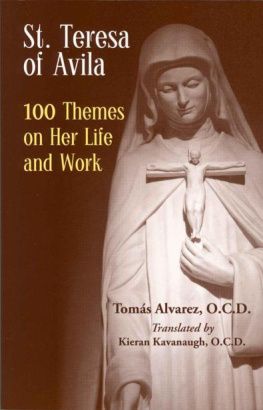St. Teresa of Avila
THE BOOK
OF HER FOUNDATIONS
A STUDY GUIDE
Marc Foley, O.C.D.
ICS Publications
Institute of Carmelite Studies
Washington, DC
REVISED EDITION 2012
Washington Province of Discalced Carmelites, Inc., 2011, 2012
ICS Publications
2131 Lincoln Road, NE
Washington, DC 20002-1199
www.icspublications.org
The text for The Book of Her Foundations
is taken from the Collected Works of Saint Teresa of Avila , volume 3,
translated by Kieran Kavanaugh, O.C.D., and Otilio Rodriguez, O.C.D.
ICS Publications.
Library of Congress Cataloging-in-Publication Data
Foley, Marc, 1949
The book of her foundations by St. Teresa of Avila: a study guide / Marc Foley.
p. cm.
Includes bibliographical references and index.
ISBN 978-0-935216-89-9
1. Teresa, of Avila, Saint, 1515-1582.
2. Discalced Carmelite Nuns Spain History 16th century.
3. Convents Spain History 16th century.
I. Teresa, of Avila, Saint, 1515 1582.
a Libro de las fundaciones. English. II. Title.
BX4700.T4F65 2011
282.092 dc22
[B]
2010043406
APPRECIATION
To my dear friend Sandra Gettings,
for the many hours that she spent helping me write this book.
Contents
Translations and Abbreviations
All passages of St. Teresas writings are quoted from The Collected Works of St. Teresa of Avila , trans. Kieran Kavanaugh, O.C.D., and Otilio Rodriguez, O.C.D., 3 vols. (Washington, D.C.: ICS Publications, 1976 1985) and The Collected Letters of St. Teresa , trans. Kieran Kavanaugh, O.C.D., 2 vols. (Washington, D.C.: ICS Publications, 2001 2007). The following abbreviations will be used in referring to Teresas works:
L The Book of Her Life (vol. 1)
ST Spiritual Testimonies (vol. 1)
S Soliloquies (vol. 1)
W The Way of Perfection (vol. 2)
M Meditations on the Song of Songs (vol. 2)
IC The Interior Castle (vol. 2)
F The Book of Her Foundations (vol. 3)
LE The Collected Letters of St. Teresa of Avila
(vol. 1 and vol. 2)
Regarding The Way , The Life , and The Foundations , the first number refers to the chapter and the second number to the paragraph. Thus, (W. 3. 4.) refers to chapter three, paragraph four of The Way of Perfection . Regarding the letters, the first number refers to the volume of the collected letters the second number refers to the number of the letter, and the third number refers to the paragraph. Thus, (LE. 1. 15. 4.) refers to volume one, letter fifteen, paragraph four of the collected letters. Regarding The Interior Castle , the first number refers to the specific dwelling place, the second number refers to the chapter, and the third refers to the paragraph. Thus, (IC. 2. 4. 3.) is a reference to the second dwelling place, chapter four, paragraph three.
Introduction
Of St. Teresa of Avilas four major works, The Book of Her Life , The Way of Perfection , The Interior Castle , and The Book of Her Foundations , the last is the least read, the least quoted, the least known. Why this is so is open to speculation. Maybe it is because Teresas teaching on prayer and the spiritual life is more systematically and fully set forth in her first three works. Perhaps, it is because readers of the Foundations become bored as they get bogged down with numerous names and historical details. I know that this was true for me. Consequently, I questioned whether it would be possible to write a reflective commentary on the Foundations . I wondered whether I would be able to find enough spiritual material to comment upon.
However, my misgivings began to vanish as I delved into the text. What I first thought would be immaterial for reflection became the raw material for reflection. St. Teresa grew in holiness not in spite of obstacles such as being entangled in lawsuits, mired down in disputes over dowries, tied up in interminable bureaucratic red tape, involved in the political infighting of the Church, and having to deal with unscrupulous businessmen, but because of these difficulties. All of these challenges set up roadblocks to the establishment of Teresas foundations, but none of them impeded her spiritual growth. Quite the contrary, they were the trials through which she triumphed.
The Foundations is much more than a chronicle of the establishment of convents. It is a record of how Teresa practiced the virtues that she wrote of in her other works charity, detachment, humility, and, most notably, patience. St. Paul rightly ranks patience as the foremost characteristic of love, for authentic love requires perseverance and a firm resolution to embrace the cross with a determined determination (W. 21. 2.).
The Foundations could be subtitled The Spirituality of the Long Haul. It chronicles fifteen long, grueling years from 1567 to 1582, during which time Teresa endured numerous trials in the process of founding seventeen convents (fifteen, which she founded personally, and two others that were founded under her direction). Teresa finished writing the Foundations toward the end of June 1582. And almost as if she knew that she had completed all the work that the Lord had assigned to her, she died four months later on October 4, 1582.
The Foundations can be read from two perspectives. It can be read as a historical account of the establishment of her convents or as a spiritual narrative. Since the purpose of this book is to make connections between Teresas life and our own, the latter is more germane to our consideration. Teresa grew in holiness in the marketplace as much as in the cloister, perhaps even more so. None of us have ever been called to found a convent, but all of us are called to practice virtue within the fray of daily life.
This book is designed for both private reflection and group discussion. Each chapter is divided into three parts. Part one is titled Summary and Background. It is a summary of the chapter, supplemented by historical information derived from various sources. Part two contains reflections on either passages found in the chapter under consideration or on the background material referred to in the summary. Part three consists of questions for reflection.
Context
At the time that Teresa entered the Incarnation in 1535, the community consisted of approximately one hundred nuns. By 1552, the number had swelled to 180, and by 1565, it had increased to nearly 200 nuns. (Teresa left the Incarnation in 1562.)
The women who entered the Incarnation came from every strata of society, from the very poor to the very rich. Those from poor backgrounds slept in common dormitories. Those from aristocratic families were provided with a suite of rooms, including a kitchen and often a private oratory. They also brought with them maids and cooks. One of these more privileged nuns was Doa Teresa de Cepeda y AhumadaSt. Teresa.
The cloister of the monastery, though prescribed, was rarely observed. Frequently, the nuns visited family and friends, sometimes for lengthy periods. Also, relatives and friends could enter the cloister, some of whom even took up residence in the monastery. For example, after their father died, Teresas sister, Doa Juana de Ahumada, lived in Teresas cell for nine years. Visiting in the monasterys front parlor was a daily occurrence, a pastime to which Teresa became very attached. The keeping of silence, though valued by the nuns, was difficult to maintain because of the size of the community and the constant traffic of laypeople.
The prayer life of the community consisted of reciting the Divine Office and daily Eucharist. However, there was no designated time set aside for mental prayer in the monasterys daily schedule. There are also indications that novices were not given any instruction in mental prayer. Teresa attests to this fact. She says that until she had read Osunas The Third Spiritual Alphabet , she did now know how to proceed in prayer or how to be recollected (L. 4. 7.).













